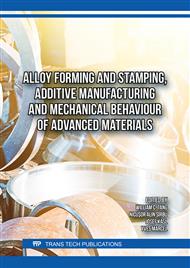p.55
p.71
p.85
p.93
p.105
p.111
p.117
p.123
p.133
Study on Aging Behavior of BL-60 Basalt Composites in Marine Atmospheric Environment
Abstract:
The marine atmospheric environment exposure test of BL-60 basalt composites was carried out in Hainan test station. The effects of marine atmospheric environment on the aging behavior of composites were studied by macro and micro morphology, moisture absorption rate, bending strength, linear expansion coefficient, glass transition temperature and infrared spectrum. The results show that the moisture absorption of the composite matrix plays a dominant role in the initial stage of exposure to the marine atmospheric environment ( 0.25 years ). With the extension of the test time ( ≥0.5 years ), the surface epoxy resin is aged and the basalt fiber is exposed. The intensity of the resin characteristic peak is obviously weakened, and the resin pulverization and shedding are greater than the moisture absorption effect. After one year of exposure to the marine atmospheric environment, the basalt fiber is almost completely exposed to the surface and exhibits a uniform cross-woven structure, and the resin characteristic peaks all disappear. After exposure to marine atmospheric environment for 1.5 years, the glass transition temperature of the composites decreased from 116.9 °C to 82.79 °C, the linear expansion coefficient decreased from 49.65 μm/(m·°C) to 31.43 μm/(m·°C), and the bending strength decreased from 570 MPa to 513 MPa. The experimental results show that the marine atmospheric environment causes aging damage to the hygroscopicity, macro and micro morphology and chemical structure of BL-60 basalt composites, which leads to the decrease of thermal and bending properties.
Info:
Periodical:
Pages:
133-140
Citation:
Online since:
November 2025
Authors:
Price:
Сopyright:
© 2025 Trans Tech Publications Ltd. All Rights Reserved
Share:
Citation:


